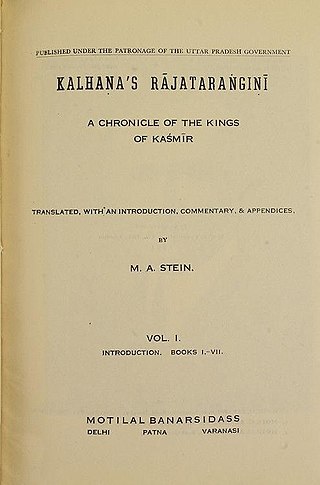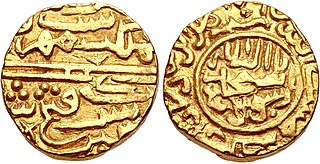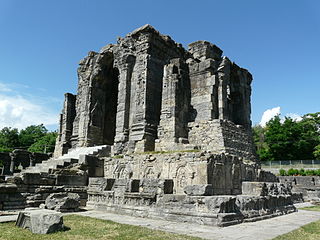This article contains information about the literary events and publications of 1642.

Srinagar is the largest city and the summer capital of Jammu and Kashmir, India. It lies in the Kashmir Valley on the banks of the Jhelum River, a tributary of the Indus, and Dal and Anchar lakes. The city is known for its natural environment, gardens, waterfronts and houseboats. It is known for traditional Kashmiri handicrafts like the Kashmir shawl, and also dried fruits. It is the 31st-most populous city in India, the northernmost city in India to have over one million people, and the second-largest metropolitan area in the Himalayas.

The history of Kashmir is intertwined with the history of the broader Indian subcontinent and the surrounding regions, comprising the areas of Central Asia, South Asia and East Asia. Historically, Kashmir referred to the Kashmir Valley. Today, it denotes a larger area that includes the Indian-administered union territories of Jammu and Kashmir and Ladakh, the Pakistan-administered territories of Azad Kashmir and Gilgit-Baltistan, and the Chinese-administered regions of Aksai Chin and the Trans-Karakoram Tract.
Sikandar Shah was the sixth sultan of the Shah Miri dynasty of Kashmir from 1389 to 1413.

Rajatarangini is a metrical legendary and historical chronicle of the north-western part of India, particularly the kings of Kashmir. It was written in Sanskrit by Kashmiri historian Kalhana in the 12th century CE. The work consists of 7826 verses, which are divided between eight books called tarangas ("waves").

Kashmiri cuisine is the cuisine of the Kashmir Valley in the Indian subcontinent. Kashmiris have developed the art of cooking to a very high degree of sophistication and evolved a cuisine quite distinct from that of any part of the world. Rice is their staple food and has been so since ancient times. The equivalent for the phrase bread and butter in Kashmiri is haakh-batta. Meat along with rice, some vegetables and salad are prepared on special occasions like Eid. A typical everyday Kashmiri meal — lunch and dinner — consists of a generous serving of rice, mutton and vegetables cooked in oil, and yoghurt.

The Shah Mir dynasty was a Kashmiri dynasty that ruled the region of Kashmir in the Indian subcontinent. The dynasty is named after its founder, Shah Mir. During the rule of the dynasty from 1339 to 1561, Islam firmly established in Kashmir.

Shankaracharya Temple or Jyeshteshwara Temple is a Hindu temple situated on top of the Shankaracharya Hill on the Zabarwan Range in Srinagar, Jammu and Kashmir, India. It is dedicated to Lord Shiva. The temple is at a height of 1,000 feet (300 m) above the valley floor and overlooks the city of Srinagar.

Chashme Shahi or Chashma i Shahi Or Cheshma Shahi, also called Chashma Shahi or Cheshma Shahi, is one of the Mughal gardens built in 1632 AD around a spring by Ali Mardan Khan, a governor of Mughal emperor Shah Jahan as per the orders of the Emperor, as a gift for his eldest son Prince Dara Shikoh. The garden is located in the Zabarwan Range, near Raj Bhawan overlooking Dal Lake in Srinagar, Kashmir, India.
Shams-ud-Din Shah Mir was a ruler of Kashmir and founder of the Shah Mir dynasty. Shah Mir is believed to have come to Kashmir during the rule of Suhadeva, where he rose to prominence. After the death of Suhadeva and his brother Udayanadeva, Shah Mir proposed for marriage to Kota Rani, she refused and continued her rule for five months till 1339 and appointed Bhutta Bhikshana as prime minister. After the death of Kota Rani, Shah Mir established his own kingship, founding the Shah Mir dynasty in 1339, which lasted till 1561.
Nilkanth Gurtoo (1925–2008) was a Kashmiri Sanskrit & Shaiva scholar and professor who translated many philosophical texts into Hindi or English.
Mohammad Ishaq Khan was a historian of Kashmir. He was Dean Academics, Dean, Faculty of Social Sciences and Head, Department of History at Kashmir University. After his superannuation in 2005, he became the Director of the newly founded Centre for Kashmir Studies and later held the Shaikhul Alam Chair at Kashmir University until August 2008.

Z. G. Muhammad is a writer born in Nowhatta, Srinagar, Kashmir, India.
Islam is the major religion which is practiced in Kashmir, with 97.16% of the region's population identified as Muslims, as of 2014. The religion - Islam, came to the region with the arrival of Mir sayed Ali shah Hamdani a Muslim Sufi preacher from Central Asia and Persia, beginning in the early 14th century. The majority of Kashmiri Muslims are Sunni Muslims and Shias account for between 20% to 25% of Muslim Population, which are majorly residing in North and central kashmir. They refer to themselves as "Koshur" in their mother language. Non-Kashmiri Muslims in Kashmir include semi-nomadic cowherds and shepherds, belonging to the 𝙂𝙪𝙟𝙟𝙖𝙧𝙨 and Bakarwal communities.

The Martand Sun Temple is a Hindu temple located near the city of Anantnag in the Kashmir Valley of Jammu and Kashmir, India. It dates back to the eighth century AD and was dedicated to Surya, the chief solar deity in Hinduism; Surya is also known by the Sanskrit-language synonym Martand. The temple was destroyed by Sikandar Shah Miri.
Sadruddin Shah, also known as Rinchan, was the first Muslim ruler of Kashmir. He ruled Kashmir from 1320 to 1323.
Mullah Nadri or Mulla Nasiri was a Persian-language poet in Kashmir during the reign of Sultan Sikandar and then at the court of Zain-ul-Abidin (1423–1473).
Tohfatu'l-Ahbab is a Farsi work by Muhammad Ali Kashmiri, presumably written in 1642. It is the biography of Shamsu'd-Din Muhammad Araki, a Shi'a Muslim missionary who visited Kashmir, Gilgit and Baltistan in the 15th and 16th century. Araki was the founder of the Nurbakhshiyyeh Sufi order in Kashmir. The work was translated into English by Kashi Nath Pandit.
K. N. Pandita, also known as Kashi Nath Pandita, is an Indian Kashmiri scholar in Persian and Central Asian Studies. Born in Jammu & Kashmir, Pandita studied and worked at Panjab University and University of Tehran, taught at the University of Kashmir and was the former professor and director at the Center of Central Asian Studies at the University of Kashmir. He was awarded UGC Emeritus Fellowship in Central Asian Studies 1978–88, and was awarded by the President and Vice President of India in 1985 and 1987 (respectively) for his academic attainments. He was a recipient of the Padma Shri in literature and education in 2017.

The Chak dynasty was a dynasty that ruled the region of Kashmir after the Shah Mir dynasty. The origins of the Chaks are unclear, they are said to be native Kashmiris of Dardic origin. The Chak dynasty ruled from 1561 to 1586. Ghazi Chak is referred as the first Chak ruler. The dynasty rose to power after the death of the Turco-Mongol military general, Mirza Muhammad Haidar Dughlat.









